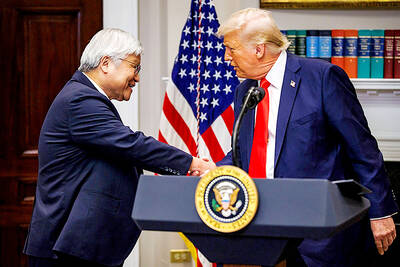Decisions being taken in Washington on the US Navy’s budget could affect the likelihood or outcome of a conflict with China over Taiwan, a new study from the Congressional Research Service says.
“Some observers consider such a conflict to be very unlikely, in part because of significant US-Chinese economic linkages and the tremendous damage that such a conflict could cause on both sides,” specialist in naval affairs Ronald O’Rourke said in the study, titled China Naval Modernization: Implications for US Navy Capabilities.
O’Rourke’s study says that Beijing wants its military to be capable of acting as an anti-access and area-denial force — “a force that can deter US intervention in a conflict in China’s near-seas region over Taiwan.”
According to the study, China’s naval modernization has several aims, but “addressing the situation with Taiwan militarily, if need be,” is its first goal.
“Decisions that [the US] Congress and the executive branch make regarding US Navy programs for countering improved Chinese maritime capabilities could affect the likelihood or possible outcome of a potential US-Chinese military conflict in the Pacific over Taiwan,” the study read.
O’Rourke cites US Naval Institute reports saying that China is developing new unmanned underwater vehicles and has modernized its substantial inventory of mines.
He also quotes the US Department of Defense as saying that “China has developed torpedo and mine systems capable of area denial in a Taiwan [conflict] scenario.”
According to the department, “estimates of China’s naval mine inventory exceed 50,000 mines, with many capable systems developed in the past 10 years,” O’Rourke’s study says.
“Although aircraft carriers might have some value for China in Taiwan-related conflict scenarios, they are not considered critical for Chinese operations in such scenarios because Taiwan is within range of land-based Chinese aircraft,” it adds.
It says that larger amphibious ships such as the Type 071 and the Type 081 would be valuable in the conduct of amphibious landings in Taiwan, although other observers say Beijing is building them to defend its territorial claims in the East China and South China seas.
In his study, O’Rourke quotes the department as saying that the People’s Liberation Army Navy “currently lacks the massive amphibious lift capability that a large-scale invasion of Taiwan would require.”
It says Beijing does not appear to be building the conventional amphibious lift required to support such a campaign, adding that “China’s navy exhibits limitations or weaknesses in several areas, including antisubmarine warfare and mine countermeasures.”
“Countering China’s naval modernization might thus involve actions to exploit such limitations and weaknesses, such as developing and procuring Virginia class attack submarines, torpedoes, unmanned underwater vehicles and mines,” the report says.
The study suggests that Congress consider whether in the coming years, the US Navy will be large enough to counter improved Chinese anti-access forces.
It also raised questions about the political and security implications that China’s growing naval capabilities — combined with the budget-driven reductions in the size of the US Navy — may have on the Asia-Pacific region.

CRITICAL MOVE: TSMC’s plan to invest another US$100 billion in US chipmaking would boost Taiwan’s competitive edge in the global market, the premier said The government would ensure that the most advanced chipmaking technology stays in Taiwan while assisting Taiwan Semiconductor Manufacturing Co (TSMC, 台積電) in investing overseas, the Presidential Office said yesterday. The statement follows a joint announcement by the world’s largest contract chipmaker and US President Donald Trump on Monday that TSMC would invest an additional US$100 billion over the next four years to expand its semiconductor manufacturing operations in the US, which would include construction of three new chip fabrication plants, two advanced packaging facilities, and a research and development center. The government knew about the deal in advance and would assist, Presidential

‘DANGEROUS GAME’: Legislative Yuan budget cuts have already become a point of discussion for Democrats and Republicans in Washington, Elbridge Colby said Taiwan’s fall to China “would be a disaster for American interests” and Taipei must raise defense spending to deter Beijing, US President Donald Trump’s pick to lead Pentagon policy, Elbridge Colby, said on Tuesday during his US Senate confirmation hearing. The nominee for US undersecretary of defense for policy told the Armed Services Committee that Washington needs to motivate Taiwan to avoid a conflict with China and that he is “profoundly disturbed” about its perceived reluctance to raise defense spending closer to 10 percent of GDP. Colby, a China hawk who also served in the Pentagon in Trump’s first team,

SEPARATE: The MAC rebutted Beijing’s claim that Taiwan is China’s province, asserting that UN Resolution 2758 neither mentions Taiwan nor grants the PRC authority over it The “status quo” of democratic Taiwan and autocratic China not belonging to each other has long been recognized by the international community, the Mainland Affairs Council (MAC) said yesterday in its rebuttal of Beijing’s claim that Taiwan can only be represented in the UN as “Taiwan, Province of China.” Chinese Minister of Foreign Affairs Wang Yi (王毅) yesterday at a news conference of the third session at the 14th National People’s Congress said that Taiwan can only be referred to as “Taiwan, Province of China” at the UN. Taiwan is an inseparable part of Chinese territory, which is not only history but

INVESTMENT WATCH: The US activity would not affect the firm’s investment in Taiwan, where 11 production lines would likely be completed this year, C.C. Wei said Investments by Taiwan Semiconductor Manufacturing Co (TSMC, 台積電) in the US should not be a cause for concern, but rather seen as the moment that the company and Taiwan stepped into the global spotlight, President William Lai (賴清德) told a news conference at the Presidential Office in Taipei yesterday alongside TSMC chairman and chief executive officer C.C. Wei (魏哲家). Wei and US President Donald Trump in Washington on Monday announced plans to invest US$100 billion in the US to build three advanced foundries, two packaging plants, and a research and development center, after Trump threatened to slap tariffs on chips made